Serviços Personalizados
Artigo
Indicadores
Links relacionados
-
 Citado por Google
Citado por Google -
 Similares em Google
Similares em Google
Compartilhar
Journal of the South African Institution of Civil Engineering
versão On-line ISSN 2309-8775
versão impressa ISSN 1021-2019
J. S. Afr. Inst. Civ. Eng. vol.53 no.1 Midrand Abr. 2011
TECHNICAL PAPER
Effectiveness of the fineness of two South African Portland cements for controlling early-age temperature development in concrete
P C Graham; Y Ballim; J B Kazirukanyo
ABSTRACT
Temperature gradients due to heat of hydration of cement can cause cracking and present serious structural and serviceability concerns in concrete structures. Engineers use a wide range of strategies to limit the potential for such cracking, mainly by minimising the maximum temperature in the concrete. This paper considers the possibility of using more coarsely ground cement as one of the strategies for reducing the maximum concrete temperature. Two cement clinkers were used to produce cements with five different levels of fineness. These ten cements were then used to make concretes which were tested in an adiabatic calorimeter to determine the heat evolution characteristics. The measured results were then used in a computational model to calculate the temperature profiles likely to occur in two types of concrete elements. The results indicate that the effect of increasing fineness on the total amount of heat released during hydration is dependent on the mineralogy and crystal composition of the cement clinker. Also, the use of coarse-ground cement as a means of reducing the maximum temperature in concrete is more effective in the case of concrete elements with high cement content but of moderate dimensions. In sections of larger dimension, coarse-ground cements show lower levels of temperature reduction but also lower thermal gradients.
Key words: cement, fineness, calorimetry, concrete temperature, modelling
INTRODUCTION
It is generally agreed that, for a given Portland cement, the rate and amount of heat liberated during the early stages of hydration (up to 28 days) is strongly influenced by the fineness of grinding of the cement (see review by Hooton et al 2005). This is intuitively correct since finer grinding means that the hydration reactions between cement and water will proceed more vigorously at early ages and hence produce more heat and at a higher maximum rate. However, as Hooton et al (2005) show, opinions vary in the literature as to the sensitivity of the relationship between cement fineness and early-age heat of hydration. Furthermore, when considering different cement types, the significance of the fineness of the cement has to be judged in relation to mineralogical parameters, such as the C3A, C3S and gypsum content, equally important factors in determining the heat characteristics of cement.
In the context of concrete construction, interest in cement fineness stems from the recognition that this may be one of the more effective of the adjustable parameters in controlling the heat evolution of the cement and, consequently, the development of thermal strains in the structure (Bentz & Haecker 1999; Binici et al 2007). In a study conducted by Bentz and Peltz (2008), in which they compared the effects of increasing watercement ratio, using a coarser cement, or replacing a portion of the Portland cement with coarse limestone in reducing the earlyage autogenous shrinkage of concrete, they conclude that: "... coarser cement offers the largest benefit in terms of reducing semiadiabatic temperature rise and effective autogenous shrinkage at 7 days ..."
There has also been a general tendency over the past few decades to increase the fineness of routinely produced Portland cements (Bentz et al 2008; Alexander 1972), partly in response to the demand for higher early strengths to support increasing rates of construction. The additional positive aspects of this development have been a more efficient use of cement by allowing target strengths to be achieved with lower cement content in concrete. Alternatively, designers could reduce concrete section sizes because higher strengths are obtained with cement content similar to those used in the past.
The trend towards finer Portland cements has raised the added concern in regard to the potential for thermal cracking of temperature-sensitive structures - from large, mass concrete sections with relatively low cement content to more moderately sized structural sections with higher cement content determined by high strength considerations. There clearly is a need for such concerns to be quantified to allow engineers in the concrete sector to better understand the structural performance implications of this development.
Bentz and Haecker (1999) and Bentz and Peltz (2008) make a strong case for a return to coarser-ground cements on the basis of both the material performance benefits and the lower energy demand in grinding. They take as the basis for this argument the fact that, at low w/c ratios and given sufficiently long times, hydration kinetics becomes less sensitive to variations in particle size distribution. It follows that coarser cements may well be suitable for so-called high-performance concretes. Accepting such an argument, and assuming all else to be equal in cement mineralogy and chemistry, the benefit of coarser-ground cements would be reduced potential for thermally induced cracking because of lower heat liberation at early ages for high-performance concretes, as well as for conventional structural and mass concretes. However, the benefit of reduced cracking potential with coarser-ground cements must be carefully quantified to allow engineers the opportunity to balance this benefit against the 'cost' of increased construction times or lower early-age strengths.
The study reported in this paper was therefore undertaken to develop an understanding of the significance of the fineness of grinding of cement as an influencing factor in the early-age heat evolution of cement. In this case, early-age refers to the time when the potential for thermallyinduced cracking due to the heat of hydration remains a concern (Ballim 2004a). Importantly, the focus of this study was to understand the effect of cement fineness and the resulting heat release characteristics - on the early-age temperature development in concrete structures.
Two cement clinkers from different production facilities were selected, primarily on the basis of previously measured performance of cements and clinkers from these production facilities (Graham 2001) as well as the difference of their calculated C 3 S content. These clinkers were each ground in a laboratory scale ball mill, using the same natural gypsum, to produce cements with five different degrees of fineness, ranging in Blaine values from 2 640 cm2/g to 4 980 cm2/g. The cements were then used to prepare concretes for testing in an adiabatic calorimeter to determine their heat of hydration characteristics. Finally, the calculated rates of heat evolution were used in a finite difference model to illustrate the effects of the changing cement fineness on earlyage temperature development in a typical low-strength mass concrete element and a smaller, high-strength structural element.
CLINKER AND CEMENT DETAILS
Two Portland cement clinkers from different manufacturing facilities in South Africa were selected in order to prepare the cements for this test programme. The two clinkers were purposely selected on the basis that clinker from these production facilities has previously been classified by Graham (2001) as nominally:
'medium heat rate' clinker (Clinker A); peak heat rate in the range: 2,5 to 3,0 W/kg
'low heat rate' clinker (Clinker B); peak heat rate in the range: 2,0 to 2,5 W/kg
The clinkers were also selected because of potential differences in their crystal composition. Table 1 shows a chemical analysis of the clinkers used and, based on the Bogue calculations as reported by Neville (1981), the clinkers reflect very different C3S content, which support their nominal status as producing different heat characteristics upon hydration (Neville 1981). Each clinker was mixed with 5% of the same natural gypsum and ground in a laboratory mill to produce five cements, each with a different degree of fineness.

Table 1 also shows the chemical composition of the gypsum used, as well as the chemical composition of the resulting cement. Table 2 shows the results of Blaine surface area determination (SABS SM748 1971) of the different cements and the milling time required to achieve the different fineness levels. Although Blaine fineness measurements are no longer a formal requirement, South African Portland cements would typically lie in the range of 3 000 cm2/g to 4 000 cm2/g.

Clinker B is clearly the 'softer' clinker, requiring less energy to mill to a particular fineness than Clinker A. The milling energy increase, which is simply the percentage increase in the milling time required to produce the stated fineness, gives an indication of the additional energy demand of the finer cements in relation to the coarse cement of each clinker type. These values give an indication of the energy cost of additional grinding, a factor that may be important in the decision to use a coarser-ground cement.
ADIABATIC CALORIMETRY
The quantity and rate of heat evolved by each of the samples were measured by means of an adiabatic calorimeter as described by Gibbon et al (1997). Ten concretes were prepared using each of the laboratory manufactured cements and an approximately 1-litre sample of each concrete was used to conduct the temperature measurement tests. The concretes were prepared using a graded silica sand and 10 mm silica stone as aggregates, and with the mixture proportions shown in Table 3. The mass of materials shown in Table 3 was sufficient to produce a mixture batch of approximately 1,2 L of concrete.
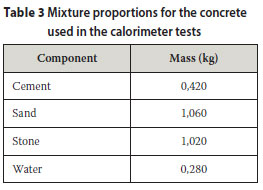
The adiabatic calorimeter, which is schematically shown in Figure 1, operates on the principle that the water in the tank is maintained at the same temperature as the hydrating concrete sample, thereby creating adiabatic conditions. The concrete sample is placed in the calorimeter no more than 15 minutes after the water has been added to the mixture and, as the concrete temperature increases, the water heater is turned on or off so that the water temperature keeps apace with the temperature of the concrete. The air pocket separating the sample from the water acts as a damping medium to eliminate any possible harmonic response between the sample and water temperature because of the inherent measurement error in the two temperature probes.

Since the rate of evolution of heat during cement hydration is influenced by the temperature at which the reaction takes place, there is no unique time-based adiabatic heat rate curve for a particular cement. Comparisons of the heat rate performances of materials must therefore be made on the basis of the degree of hydration or maturity. In the discussion which follows, the calorimeter test results are expressed in terms of maturity or hours, which refers to the equivalent time of hydration at 200C. This form of expression of the heat rate function and the justification for its use is described by Ballim and Graham (2003) and Ballim (2004a).
RESULTS AND DISCUSSION
Total heat evolved during hydration
Figures 2 and 3 show the total heat evolved by the Clinker A and Clinker B cements respectively, with reference to maturity time expressed in t20 hours.
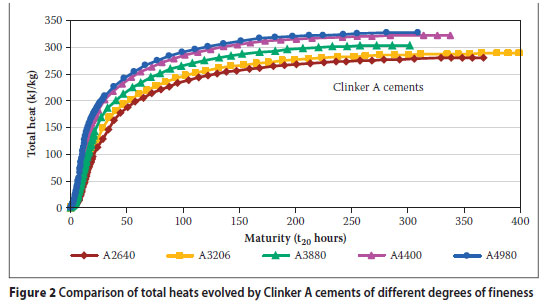
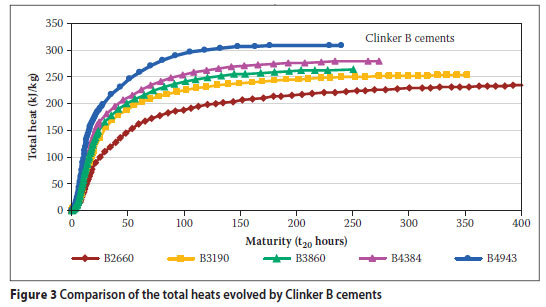
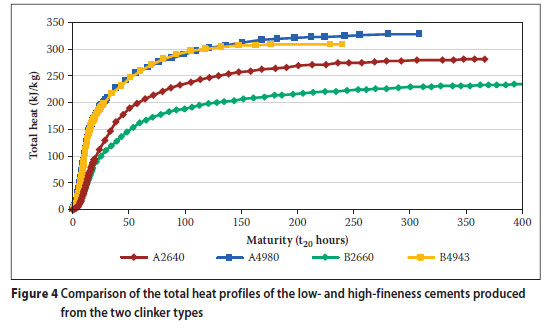
While increasing finess results in higher total heat output for both clinkers, it is clear that the amount of heat released by Clinker B is more sensitive to the fineness of grinding than Clinker A. The large step increases in the heat curves of the Clinker B cements from the coarse cement to the three medium-fineness cements, and then from the medium to the fine cement, is likely to be because of the preferential grinding of particular phases of this 'softer' clinker cement (see grinding times in Table 2). However, this aspect would require further investigation.
A comparison between to the two clinker types is shown in Figure 4, where the curves of only the low- and high-fineness cements are reproduced. While the Clinker A cement shows significantly higher heat output than the Clinker B cement at a nominal cement fineness of 2 650 cm2/g, the total heat profiles of the cements produced from the two clinkers are very similar at a nominal fineness of 5 000 cm2/g. Both these clinkers are produced to manufacture cements that comply with the requirements of the national cement specification, SABS EN 197-1:2000. However, the results presented in Figures 2 to 4 show that, as the fineness of grinding of cement increases, the heat of hydration characteristics of the cement decreases in its sensitivity to changes in the chemistry and crystallography of the clinker used to produce the cement.
It should be noted that, at late ages (>250 t20 hours), the rate of hydration of the cement can become so low that the calorimeter is not able to detect changes in the temperature of the concrete sample. While the curves in Figures 2 to 4 flatten out when this point is reached, this 'plateau' should not be interpreted as a cessation of the hydration process.
Figure 5 presents a more complete comparison of the performance of the two clinker types over the range of cement finenesses tested. Figure 5(a) shows the variation in the 'plateau' value of total heat as measured in the adiabatic calorimeter, as the fineness of the cement is varied. The 'plateau' value was taken as the maximum measured value of total heat output at a point when the rate of heat evolution becomes less than 0,05 kJ/kg/t20hr. This figure shows that, at the low end of the fineness spectrum, the total heat output may well be dominated by clinker characteristics such as the relative proportions of C3S and C2 Sin the clinker. However, in terms of total heat output, Clinker B cement is more sensitive to increasing fineness, and this is likely to be a result of different crystal morphologies of the two cement clinkers (Taylor 1997), resulting in different hydration characteristics.
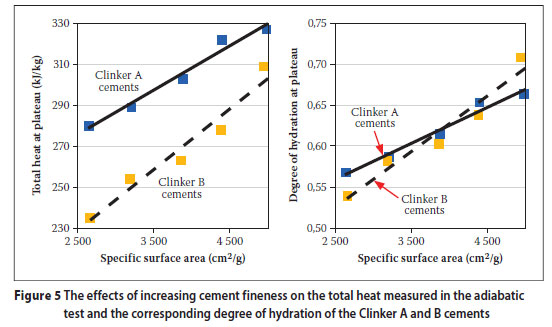
Of course, the results shown in Figure 5(a) represent very different extents of hydration because, as the fineness of the cement is increased, a greater proportion of the cement is hydrated in a given time. It is therefore also necessary to consider the heat output results in terms of the degree or extent of hydration of each of the cements tested. A number of authors (Taylor 1997; Van Breugel 1998; Maekawa et al 1999) have proposed that the total heat produced upon complete hydration of cement can be obtained by adding the amounts of heat liberated by the individually reacting crystal components. The data provided by Maekawa et al (1999) for the heat liberated by different cement compounds was applied to the calculated crystallographic composition of the cements as shown in Table 1. Using this approach, the total heats of hydration for clinkers A and B were calculated to be 493 kJ/kg and 436 kJ/kg respectively. It should be noted that these are purely theoretical maximum heat values, principally because the crystallographic compositions determined using the Bogue formulations will, at best, indicate a likely rather than an actual crystallographic composition (Taylor 1997). Nevertheless, bearing this caveat in mind, the calculated maximum heats provide a useful theoretical basis for comparing the relative performance of the two cements when full hydration has not been obtained. The degree of hydration at any time t is then expressed as the ratio of the heat released up to time t, to the calculated value of heat that would be released upon complete hydration, as indicated above.
Figure 5(b) shows the variation in the 'plateau' heat values for the cements, but normalised by being expressed in terms of the degree of hydration. This form of expression brings the results of the two clinker types closer together, possibly suggesting an equivalent fineness relationship for the two clinkers. Nevertheless, even when compared on the basis of the degree of hydration, the Clinker B cements continue to show a higher propensity for hydration to be stimulated by increased fineness of grinding. This again indicates that the effects of increasing cement fineness on the early-age hydration heat characteristics depend not only on the quantitative crystal composition of the cement, but also on the hydration characteristics and the possible polymorph structure of the cement minerals (Taylor 1997).
Rates of heat evolution during hydration
Figures 6 and 7 show the rates of heat evolution for the cements made from Clinkers A and B respectively, over the first 60 t 2 0 hours. The curves coalesce after this time and there is little detail that is of interest to this discussion. Both figures show that the peak rate of heat evolution increases as the fineness of the cement increases. Table 4 presents the peak heat rate values for each of the cements, but also indicates that, except for the fine Clinker B cement, the peak heat rate occurs earlier as the fineness of the cement is increased. While this effect is noted with both of the clinkers tested, the impact appears to be larger with the Clinker A cements than with the Clinker B cements.
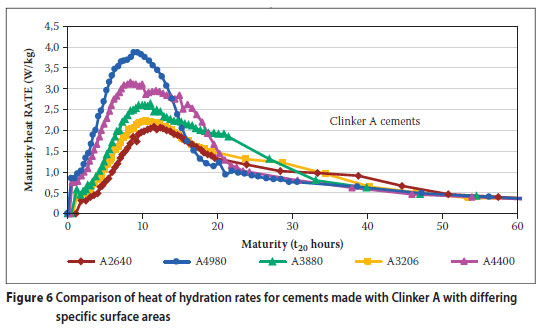
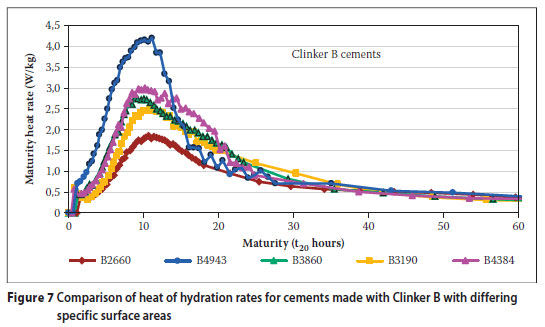

A number of the heat rate curves show a secondary peak on the descending limb after the main peak. This secondary acceleration in heat evolution activity is usually ascribed to a renewed formation of ettringite (Taylor 1997) and/or the conversion of ettringite to monosulphate (Maekawa et al 1999; Odler 1998). This secondary peak seems to occur earlier, as the fineness of the cement is increased, to a point where the peak is no longer clearly recognisable for the concrete samples with the finest cement and appears to coalesce with the main heat rate peak. This observation is supported by Sarkar (1990), who shows SEM micrographs of calcium monosulphate plates in cement paste near the peak heat rate point after nine hours of hydration.
Figure 8 shows a comparison of the heat rate curves for the low- and highfineness cements of each clinker type. The more coarse Clinker A cement shows a higher peak heat rate than the corresponding Clinker B cement and this is reversed in the case of the high-fineness cements. However, it is also interesting to note that, at both fineness levels, the Clinker B cements show a more rapid decline of heat rate after the peak rate is achieved. This is important from the point of view of temperature development in concrete structures, since a shorter duration of the peak heat rate is likely to result in a lower maximum temperature development in situ.
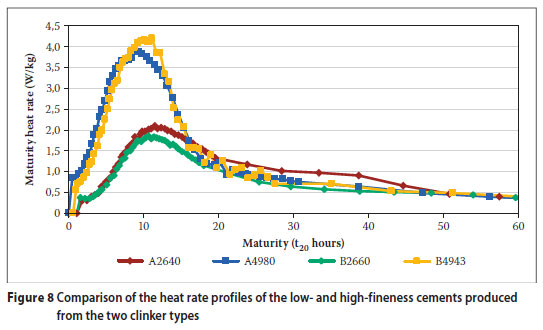
IMPLICATIONS FOR TEMPERATURE DEVELOPMENT IN CONCRETE
In order to consider the implication of changing fineness of the cements tested on temperature development in actual concrete structures, the measured heat rate profiles were used to generate temperature profiles for two hypothetical concrete elements. The finite difference temperature prediction model proposed by Ballim (2004b) was used in this analysis. For clarity of presentation, only the low-, medium- and high-fineness cements of each clinker type were used in the analysis.
Two structures were assessed using the heat rate curves as input into the model:
A concrete block, typical of that used for dam wall construction, measuring 4 m wide and 3 m deep; cement content = 200 kg/m3; concrete specific heat capacity = 1 118 J/kg.ºC; concrete density = 2 410 kg/m3.
A fully supported concrete beam, measuring 500 mm square; cement content = 450 kg/m3; concrete specific heat capacity = 1 151 J/kg.ºC; concrete density = 2 490 kg/m3.
The thermal conductivity of the concrete was taken as 2,7 W/m.ºC as suggested by Van Breugel (1998) for granite aggregate concrete.
Furthermore, the external and processing conditions used in the modelling exercise for both structures were as follows:
the concrete is cast directly onto rock with a thermal conductivity of 1,2 W/m.ºC
concrete is placed at a temperature of 17ºC at 10h00 and the ambient temperature varies sinusoidally between 12ºC and 25ºC
the timber side formwork is held in place for 18 hours after casting, during which time the heat transfer coefficient from these surfaces is taken as 5 W/m2.ºC
upon removal of the formwork, the heat transfer coefficient for the side surfaces is taken as 25 W/m2.ºC.
Figure 9 shows the modelled temperatures for the large concrete block from the vertical surface to the centre of the block, across a section 1,5 m below the top surface and at the time when the maximum internal temperature occurs. This figure shows that:
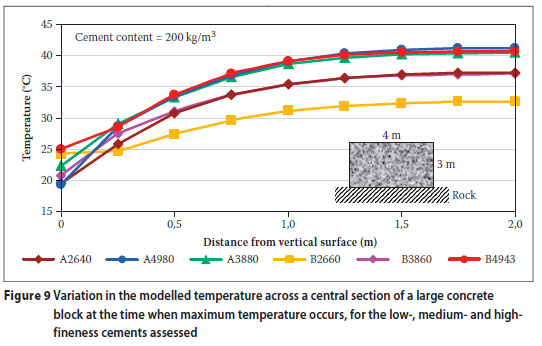
the lowest maximum temperature and the lowest temperature gradient are achieved when coarsely ground Clinker B cement is used as the binder
the coarse Clinker A cement shows a similar temperature profile as the medium-fineness Clinker B cement
there is little difference between the temperature profiles generated by the highfineness cements for both clinkers and, although showing lower heat of hydration characteristics, the medium-fineness Clinker A cement gives a temperature profile that is similar to that of the highfineness cements
the highest temperature gradient occurs when the high-fineness Clinker A cement is used.
Figure 9 shows that, for large concrete elements with low to modest cement content, the benefit (up to 9ºC reduction in the peak temperature) of a nominally low-heat rate cement like that produced from Clinker B can only to be achieved if the cement is ground to a fineness below 3 000 cm2/g.
Figure 10 compares the temperature profiles across a central section of the beam element with smaller dimension but higher cement content than the section analysed in Figure 9. In this case the maximum temperature obtained in the concrete is strongly influenced by the fineness of grinding of the cement. Given that the starting temperature of all the concretes analysed was 17ºC, the coarse cements cause fairly modest temperature increases in the concrete, with a particularly low temperature gradient across the section. The relatively high temperature gradient of the medium-fineness Clinker A cement may well be a feature of the external temperature at the time that the maximum internal temperature occurs. Nevertheless, even this temperature gradient is not unusually large. In the case of the high-fineness cements, there is almost no difference in the temperature profiles generated by the Clinker A and B cements.
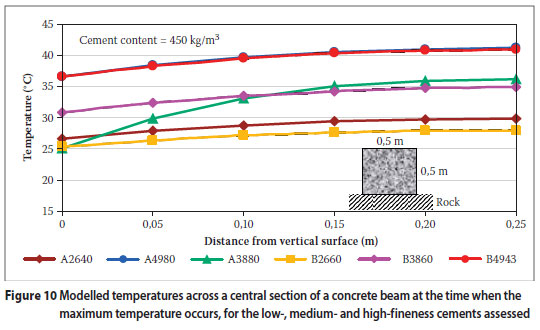
Figure 10 indicates that, for sections of modest dimension, the maximum temperatures can be effectively controlled by placing an upper limit on the fineness of grinding of the cement. Given the sizes of the samples tested, this may well be the basis for the statement by Sarkar (1990) that cement fineness (and the presence of alkali sulphates) play a dominant role in the strength development pattern in concrete, to the point of suggesting that particle size outweighs the C3S content in importance to the hydration reactions. However, as demonstrated with the simulations above, in actual concrete structures with realistic dimensions, the benefits of accelerated strength development through finer grinding of the cement may be lost because of the threat of cracking due to higher thermal strains.
In undertaking a cost-benefit analysis of the fineness of grinding of cement, an important factor to consider is the energy required for additional grinding of the cement - and the consequent implications for the carbon dioxide burden that cement milling adds to the environment. There may well be sound technical argument for using coarser cements (Bentz & Haeker 1999) and this avenue of research should be more vigorously pursued.
CONCLUSIONS
This paper was aimed at assessing the effects of increasing the fineness of cement on the heat of hydration and, consequently, on temperature development in concrete. The conclusions derived from the tests results and analyses for the two cements tested, are summarised below:
Increasing the fineness of grinding of cement from 2 650 cm2/g to 5 000 cm2/g results in an increase in the total measured heat output of 17% in the case of the Clinker A cements and 32% in the case of the Clinker B cements.
This increase is partly explained by the increase in the degree or extent of hydration of the finer cement over the time period of assessment. However, the difference in the relative increases of total heat output between the two clinkers assessed appears to be caused by differences in the mineralogical content (mainly C3S and C2S) of the two cement clinkers.
Within the range of cement fineness assessed in this study, there is an approximately linear relationship between the fineness of grinding, expressed as specific surface area, and the total amount of heat released in the adiabatic test.
Increasing the fineness of cement increases the peak rate of heat evolution during hydration and generally causes the peak
heat rate to occur earlier. Also, the secondary peak heat rate, normally ascribed to conversion of ettringite, occurs earlier as the fineness of the cement is increased, so that, at a fineness of around 5 000 cm2/g, the primary and secondary peaks appear to coalesce.
The low heat rate benefit of Clinker B, which has a particularly low calculated C3S content, is only noted if the cement is fairly coarsely ground. At high levels of fineness, this cement showed similar heat performance as that of the Clinker A cements.
In the case of large concrete elements with relatively low cement content, the coarsely ground Clinker B cement gave the lowest maximum temperature and the lowest temperature gradient. Finely ground cements showed similar temperature profiles, regardless of whether Clinker A or Clinker B was used. The benefit of using coarse-ground cement appears to lie in the reduction of temperature gradients with the consequent reduction in cracking potential.
In the case of smaller concrete structural elements with fairly high cement content, the fineness of the cement appears to be an overwhelming factor in determining the maximum temperature profiles in the structure. Provided that the rate of strength gain is suitable, coarse-ground cement may well be an effective means for controlling the maximum temperatures in such structures.
ACKNOWLEDGEMENTS
The authors gratefully acknowledge the assistance of staff at Afrisam (Africa) (Pty) Ltd for their assistance in grinding and preparing the cement samples for this investigation. We also acknowledge the continuing financial and logistical support of the Cement & Concrete Institute, National Research Foundation and Eskom (TESP) for our research work.
REFERENCES
Alexander, K M 1972. The relationship between strength and the composition and fineness of cement. Cement and Concrete Research, 2: 663-680. [ Links ]
Ballim, Y & Graham, P C 2003. A maturity approach to the rate of heat evolution in concrete. Magazine of Concrete Research, 55(3): 249-256. [ Links ]
Ballim, Y 2004a. Temperature rise in mass concrete elements - Model development and experimental verification using concrete at Katse dam. Journal of the South African Institution of Civil Engineering, 46(1): 9-14. [ Links ]
Ballim, Y 2004b. A numerical model and associated calorimeter for predicting temperature profiles in mass concrete. Cement and Concrete Composites, 26(6): 695-703. [ Links ]
Bentz, D P & Haecker, C J 1999. An argument for using coarse cements in high-performance concretes. Cement and Concrete Research, 29(4): 615-618. [ Links ]
Bentz, D P & Peltz, M A 2008. Reducing thermal and autogenous shrinkage contributions to early-age cracking. ACI Materials Journal, 105(4): 414-420. [ Links ]
Bentz, D P, Sant, G & Weiss, J 2008. Early age properties of cement-based materials: 1. Influence of cement fineness. ASCE Journal of Materials in Civil Engineering, 20(7): 502-508. [ Links ]
Binici, H, Aksogan, O, Cagatay, I H, Tokyay, M & Emsen, E 2007. The effect of particle size distribution on the properties of blended cements incorporating GGBFS and natural pozzolan (NP). Powder Technology, 177: 140-147. [ Links ]
Gibbon, G J, Ballim, Y & Grieve, G R H 1997. A lowcost, computer-controlled adiabatic calorimeter for determining the heat of hydration of concrete. Journal of Testing and Evaluation (ASTM), 25(2): 261-266. [ Links ]
Graham, P C. 2001. Heat evolution of South African cements and the implications for mass concrete structures. Unpublished PhD thesis, Johannesburg: University of the Witwatersrand. [ Links ]
Hooton, R D, Boyd, A J & Bhadkamkar, D 2005. Effect of cement fineness and C3S content on properties of concrete: A literature review. PCA R&D Serial No. 2871, Portland Cement Association. [ Links ]
Maekawa, K, Chaubey, R & Kishi, T 1999. Modelling of Concrete Performance. London: E and F N Spon. [ Links ] Neville, A M 1981. Properties of Concrete, 3rd ed. London: Pitman International. [ Links ]
Odler, I 1998. Hydration, setting and hardening of Portland cement. In: Hewlett, P C (Ed). Lea's Chemistry of Cement and Concrete, 4th ed. London: Arnold. [ Links ]
SABS EN 197-1: 2000: Composition, specifications and conformity criteria for common cements. Pretoria: South African Bureau of Standards. [ Links ]
SABS SM 748: 1971: Specific surface of cement. Pretoria: South African Bureau of Standards. [ Links ]
Sarkar, S L 1990. Effect of Blaine fineness reversal on strength and hydration of cement. Cement and Concrete Research, 20: 398-406. [ Links ]
Taylor, H F W 1997. Cement Chemistry, 2nd ed. London: Thomas Telford. [ Links ]
Van Breugel, K 1998. Prediction of temperature development in hardening concrete. In: Springenschmid, R (Ed.), Prevention of Thermal Cracking in Concrete at Early Ages, RILEM Report 15, London: E and F N Spon. [ Links ]
 Contact details:
Contact details:
School of Civil & Environmental Engineering University of the Witwatersrand
Private Bag 3, Wits,2050
South Africa
T: +27 (0)11 717 7135 F: +27 (0)11 717 1129
E: peter.graham@wits.ac.za
Contact details:
School of Civil & Environmental Engineering University of the Witwatersrand
Private Bag 3, Wits,2050
South Africa
T: +27 (0)11 717 1121 F: +27 (0)11 717 1129
E: yunus.ballim@wits.ac.za
Contact details:
Advanced Cement Training & Projects
PO Box 1166, Wilgeheuwel, 1736
South Africa
T: +27 (0)83 557 3789 F: +27 (0)11 675 2551
E: cemtraining@gmail.com E: cemtraining@telkomsa.net
 | PETER GRAHAM is a professional engineer and holds a PhD in engineering. He graduated as mechanical engineer, and in his early career worked as an engineer on the gold mines. He later became the CEO of a company that manufactured tunnelling equipment and subsequently joined a cement extender producer, where he was the CEO for a number of years. Currently he is retired and is an Honorary Research Fellow at the University of the Witwatersrand where he is involved in research concerning the heat evolution characteristics of cements and their implications for concrete structures. He is also a Fellow of the South African Institution of Mechanical Engineering. | |
 | YUNUS BALLIM holds BSc (Civil Eng), MSc and PhD degrees from the University of the Witwatersrand (Wits). Between 1983 and 1989 he worked in the construction and pre-cast concrete industries. He has been at Wits since 1989, starting as a Research Fellow in the (then) Department of Civil Engineering and currently holds a personal professorship in this School. He was the head of the School of Civil & Environmental Engineering from 2001 to 2005. In 2006 he was appointed as the DVC for academic aff airs at Wits. From 2003 to 2005, he served as the founding President of the African Materials Research Society. | |
 | JEAN BOSCO KAZIRUKANYO holds an MSc Eng (Cement Chemistry & Process) from the Mendeleev University, Moscow, a PhD on Superplasticisers (ULB, Brussels), and did his post-doctoral research on Concrete Technology (TU Delft, Netherlands). Previously he was Senior R&D Manager for Heidelberg & Holcim cement groups. Currently he is Director of Advanced Cement Training & Projects, Johannesburg. |














